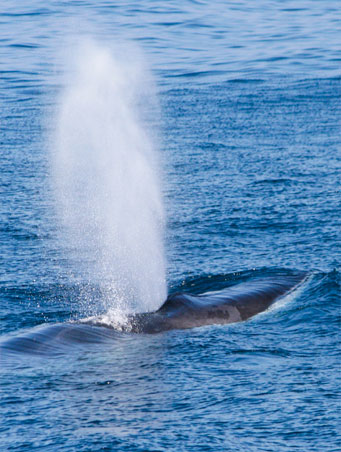Risso’s dolphins are large members of the Delphinidae family, presenting a distinctive coloration that can vary throughout their lives. Newborns and calves are in fact dark grey and, as they grow up, their skin turns to a light grey colour due to the scars obtained during social interactions with other individuals. Older individuals may be completely white! Their body is robust with a narrow tailstock and can weigh 300 to 500 kg, for a 4 metres length. They have a bulbous, squarish head with a vertical cleft and an indistinguishable beak. These features make them quite easy to identify, especially at a close range.


Risso’s dolphin can dive up to 300 m and hold their breath up to 30 minutes. However, the average dive depth is 50 m and can last up to 10 minutes. They feed mainly on deepwater squid and octopuses, sometimes cuttlefish. Most feeding appears to occur at night or late afternoon.
Risso’s dolphins are typically found in groups of 10 to 30 animals. Males group in highly stable social units, while females form nurseries during calving season.
During day time they regularly socialise, rest or travel. When socialising, they can breach, spyhop, lobtail and slap the flippers. One characteristic behaviour of Risso’s dolphin is the head standing. The animal stands in a vertical position with the head underwater and the tail out of the water.
Individuals become sexually mature when they are 8-10 years (female) 10-12 years old (males). The gestation period lasts approximately 13 to 14 months. Female give births to a single calf every 2-3 years all year round with regional peak in spring, summer or autumn. Newborns are 1 meter to 1,67 meter long and weigh about 20 kg. A Risso’s dolphin can live up to 50 years.

The common bottlenose dolphin is most likely the best known of all cetaceans, figured in legends and being known since the ancient Greeks ...

The short-beaked common dolphin is a medium-sized dolphin, easily distinguishable by a very unique hourglass-like pattern on the side of ...

The striped dolphin is the most abundant dolphin species in the Mediterranean Sea. It is a small, active and energetic dolphin, usually s ...

Risso’s dolphins are large members of the Delphinidae family, presenting a distinctive coloration that can vary throughout their ...

The fin whale is the second longest animal in the world, after the blue whale, reaching a length of 23 m and weighting up to 50 tons. The ...

The sperm whale is easily recognisable by its massive heads which contains the spermaceti: the world’s most powerful natural sonar or ech ...